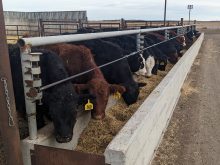Western Producer staff
It is the silent majority that puzzles those trying to figure out the meaning of the Canadian Wheat Board advisory committee election.
At a time when the single-desk export monopoly of the board is under its greatest challenge in half a century, fewer than 40 percent of enfranchised farmers bothered to cast a ballot.
In an election in which both sides made the future of the board’s powers an issue, fully 60 percent of farmers counted themselves out of the debate.
Afterwards, many spokesmen from both sides wrung their hands and wished more had voted.
Read Also

Topsy-turvy precipitation this year challenges crop predictions
Rainfall can vary dramatically over a short distance. Precipitation maps can’t catch all the deviations, but they do provide a broad perspective.
Behind the claims of victory or concessions of defeat, though, there was puzzlement. Why did so few vote? Where do they stand? It is a pivotal question.
In the hands of the 60 percent lies the future of the Canadian Wheat Board.
Almost certainly, before this issue is settled finally, the federal government will supplement its farmer-leader consultations with a direct farmer vote.
So where does the silent majority stand?
The curious thing about the wheat board election is that the pro-board result contradicted every attempt at market research by the so-called professionals.
The Dunvegan Group of Calgary, the Angus Reid Group of Winnipeg and United Grain Growers’ AgDecision Research and Consulting all have concluded after farmer surveys that the majority want competition for the board, at least in continental barley marketing and maybe beyond that.
Why didn’t the vote reflect that? Could the research be wrong?
Olev Wain of the Dunvegan Group reflects the professional opinion-collectors in his apparent bewilderment.
“I don’t have a reading on what happened,” he said last week. “You can be sure it was a surprise.” All the questioners will be back at it in the months ahead, trying to figure out if their first efforts were wrong, if farmers lied, or if the mystery lies in that 60 percent.
It could be that the pro-board people were more motivated and got out to vote, ventured Wain. It would also be reasonable to assume those who want a change in the board would be motivated.
It could be that farmers knew the advisory committee is powerless to change anything and didn’t bother to vote, ventures Reform MP Leon Benoit. But wouldn’t it would be just as reasonable to assume that pro-change farmers would use every avenue available to send a message to government?
The result has left the questioners with some questions about their own results.
Ted Allen of UGG, who fervently believes in competition for the board and who believes in the pro-competition findings of company-owned AgDecision, will not even venture an answer to the question of what went wrong.
“I don’t know. The vote does not reflect the research we have. I want to see more hard evidence before I even speculate.”
It could be that the 40 percent represent the committed, among whom the board obviously has an edge. Those in the middle may be the battleground for the next great campaign over the board.














